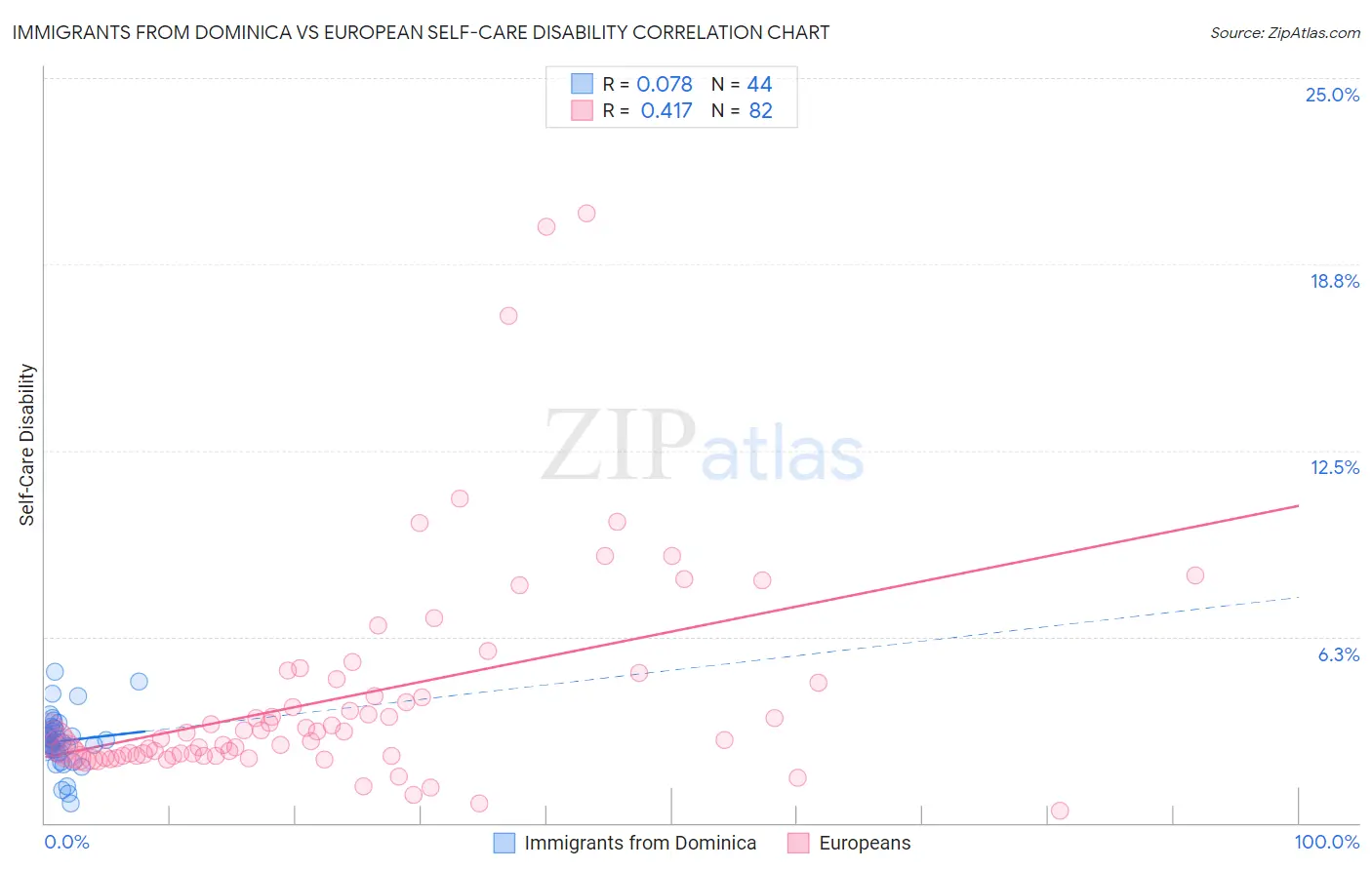Immigrants from Dominica vs European Self-Care Disability
COMPARE
Immigrants from Dominica
European
Self-Care Disability
Self-Care Disability Comparison
Immigrants from Dominica
Europeans
2.8%
SELF-CARE DISABILITY
0.0/ 100
METRIC RATING
317th/ 347
METRIC RANK
2.4%
SELF-CARE DISABILITY
95.8/ 100
METRIC RATING
100th/ 347
METRIC RANK
Immigrants from Dominica vs European Self-Care Disability Correlation Chart
The statistical analysis conducted on geographies consisting of 83,776,311 people shows a slight positive correlation between the proportion of Immigrants from Dominica and percentage of population with self-care disability in the United States with a correlation coefficient (R) of 0.078 and weighted average of 2.8%. Similarly, the statistical analysis conducted on geographies consisting of 559,811,147 people shows a moderate positive correlation between the proportion of Europeans and percentage of population with self-care disability in the United States with a correlation coefficient (R) of 0.417 and weighted average of 2.4%, a difference of 19.9%.

Self-Care Disability Correlation Summary
| Measurement | Immigrants from Dominica | European |
| Minimum | 0.64% | 0.41% |
| Maximum | 5.1% | 20.5% |
| Range | 4.4% | 20.0% |
| Mean | 2.7% | 4.2% |
| Median | 2.7% | 2.9% |
| Interquartile 25% (IQ1) | 2.4% | 2.3% |
| Interquartile 75% (IQ3) | 3.1% | 4.7% |
| Interquartile Range (IQR) | 0.69% | 2.5% |
| Standard Deviation (Sample) | 0.88% | 3.7% |
| Standard Deviation (Population) | 0.87% | 3.7% |
Similar Demographics by Self-Care Disability
Demographics Similar to Immigrants from Dominica by Self-Care Disability
In terms of self-care disability, the demographic groups most similar to Immigrants from Dominica are Assyrian/Chaldean/Syriac (2.8%, a difference of 0.010%), Menominee (2.8%, a difference of 0.13%), Spanish American Indian (2.9%, a difference of 0.17%), Immigrants from Cuba (2.8%, a difference of 0.23%), and Chickasaw (2.9%, a difference of 0.38%).
| Demographics | Rating | Rank | Self-Care Disability |
| British West Indians | 0.0 /100 | #310 | Tragic 2.8% |
| Puget Sound Salish | 0.0 /100 | #311 | Tragic 2.8% |
| Immigrants | Caribbean | 0.0 /100 | #312 | Tragic 2.8% |
| Spanish Americans | 0.0 /100 | #313 | Tragic 2.8% |
| Creek | 0.0 /100 | #314 | Tragic 2.8% |
| Immigrants | Cuba | 0.0 /100 | #315 | Tragic 2.8% |
| Menominee | 0.0 /100 | #316 | Tragic 2.8% |
| Immigrants | Dominica | 0.0 /100 | #317 | Tragic 2.8% |
| Assyrians/Chaldeans/Syriacs | 0.0 /100 | #318 | Tragic 2.8% |
| Spanish American Indians | 0.0 /100 | #319 | Tragic 2.9% |
| Chickasaw | 0.0 /100 | #320 | Tragic 2.9% |
| Navajo | 0.0 /100 | #321 | Tragic 2.9% |
| Comanche | 0.0 /100 | #322 | Tragic 2.9% |
| Seminole | 0.0 /100 | #323 | Tragic 2.9% |
| Cherokee | 0.0 /100 | #324 | Tragic 2.9% |
Demographics Similar to Europeans by Self-Care Disability
In terms of self-care disability, the demographic groups most similar to Europeans are Immigrants from Scotland (2.4%, a difference of 0.040%), Immigrants from Israel (2.4%, a difference of 0.10%), Immigrants from Poland (2.4%, a difference of 0.18%), Croatian (2.4%, a difference of 0.22%), and Alsatian (2.4%, a difference of 0.25%).
| Demographics | Rating | Rank | Self-Care Disability |
| Immigrants | Latvia | 97.0 /100 | #93 | Exceptional 2.4% |
| Macedonians | 96.9 /100 | #94 | Exceptional 2.4% |
| Immigrants | Asia | 96.9 /100 | #95 | Exceptional 2.4% |
| Immigrants | Chile | 96.7 /100 | #96 | Exceptional 2.4% |
| Swiss | 96.6 /100 | #97 | Exceptional 2.4% |
| Immigrants | Poland | 96.4 /100 | #98 | Exceptional 2.4% |
| Immigrants | Israel | 96.1 /100 | #99 | Exceptional 2.4% |
| Europeans | 95.8 /100 | #100 | Exceptional 2.4% |
| Immigrants | Scotland | 95.7 /100 | #101 | Exceptional 2.4% |
| Croatians | 95.0 /100 | #102 | Exceptional 2.4% |
| Alsatians | 94.9 /100 | #103 | Exceptional 2.4% |
| Bhutanese | 94.5 /100 | #104 | Exceptional 2.4% |
| Carpatho Rusyns | 94.4 /100 | #105 | Exceptional 2.4% |
| Immigrants | Indonesia | 94.3 /100 | #106 | Exceptional 2.4% |
| British | 94.3 /100 | #107 | Exceptional 2.4% |